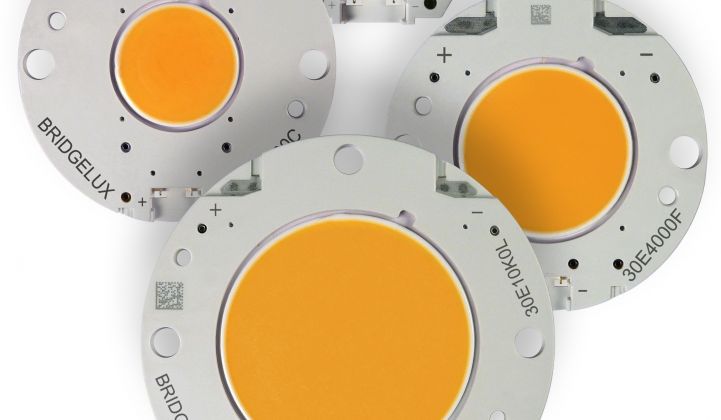A lot of factors go calculating the extra costs, and extra benefits, of LED lighting over traditional incandescent or fluorescent lights. One of the key costs remains the challenge of integrating light-emitting diodes -- semiconductors, with the fast development and tech turnover times of that industry -- into a lighting industry that doesn’t change much at all over the decades.
Bridgelux, the LED startup, launched its new Vero product line on Wednesday meant to make LED lighting fixtures simpler and more modular to build. Consider it another move toward integration in the LED industry, where both lighting giants like GE, Philips and Sylvania and startups like Bridgelux, Digital Lumens, LEDnovation and LEDWiser are competing to define what the LEDs of the future will look like.
Beyond coming with higher flux density and an increase in lumens per watt by up to 20 percent over existing Bridgelux LED arrays, the new Vero line of products also decouples the LED light engine from the body or frame that holds the engine in place, according to Jason Posselt, vice president of global marketing at Bridgelux. LED engines are built on metal circuit boards that have good thermal and lighting properties, but they need to be soldered to some kind of frame that holds them in place -- and because they’re good at conducting heat away from the LED, they’re also tricky to solder.
The new Vero line, by contrast, includes a selection of different LED engines, along with a set of plastic bodies that clip into place around the engine. That allows for faster and easier assembly in the factory, along with a host of quality control improvements like optic locators, bar codes for part traceability, and the like, he said.
Bridgelux, which works with a number of unnamed lighting customers, as well as named partners like Chevron Energy Services and Tyco International, has already worked with some partners to integrate its LED engines into plastic bodies from other companies, Posselt said. But putting the two together as one solution is far less common -- “I believe this is a first of a kind product in the market,” he said.
It’s certainly not the first move in the LED industry toward integration, however. According to this summer’s Enterprise LED market research report by Groom Energy and Greentech Media, the share of an LED fixture’s bill of materials attributable to the LED components themselves have fallen from 50 percent a few years ago to 20 percent to 30 percent of the cost -- and prices are expected to keep falling based on newer chip technology and manufacturing scale. That means balance-of-system costs -- optics, thermal management, mechanical structure and power, and of course, manufacturing and supply chain integration costs -- are big new targets for cost reduction and innovation in today’s LED marketplace.
The same logic has led to a string of acquisitions in the LED space, such as LED maker Cree’s purchase of lighting fixture manufacturer Ruud/Beta last year. Startups like Lunera and Digital Lumens are building their own fixtures in various formats to serve specific markets, such as high-end commercial spaces or warehouse lighting. We've also seen partnerships that are linking LED lights to smart lighting control systems from companies like Redwood Systems and Daintree Networks.
Of course, Asian competitors including LG, Panasonic, Samsung, Sharp and Toshiba have announced plans to enter the LED market as well. In the future, Chinese manufacturers are bound to offer stiff price competition to U.S. and European lighting giants and startups alike. Squeezing efficiencies out of every stage of the process will be critical for companies trying to grab market share in the new LED lighting market.
Bridgelux hasn’t come up with any hard numbers on how its Vero product line might help reduce costs and improve efficiency for its partners on that front. But Posselt said that the company is already testing the product with certain key customers, and expects general commercial availability early next year.



